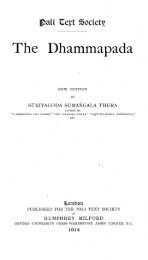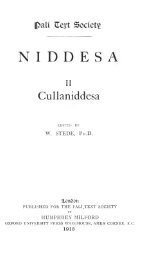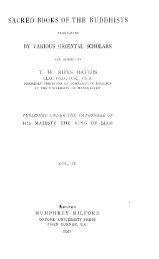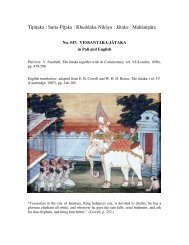Lessons In Practical Buddhism - Sirimangalo.Org
Lessons In Practical Buddhism - Sirimangalo.Org
Lessons In Practical Buddhism - Sirimangalo.Org
You also want an ePaper? Increase the reach of your titles
YUMPU automatically turns print PDFs into web optimized ePapers that Google loves.
other recommended him to disrobe and so he went to see<br />
the Buddha. The Buddha immediately understood the<br />
problem, as well as the solution. Looking back into the past,<br />
he saw that Culapanthaka had once been a king who had a<br />
profound experience of impermanence when wiping sweat<br />
off of his face with a clean cloth and seeing how it became<br />
soiled. <strong>In</strong> order to take advantage of this distant realization,<br />
he gave Culapanthaka a clean cloth and told him to go stand<br />
in the sun and rub it with his hand. That very morning,<br />
Culapanthaka became an Arahant.<br />
Teaching meditation effectively is not a simple matter. A<br />
meditator’s state of mind can change many times through<br />
the course of their practice, as prevalent character traits<br />
make way for latent ones, which are in turn replaced by<br />
others. Meditation practice can be likened to peeling an<br />
onion; when you peel off one layer, you see there is an<br />
entirely new layer underneath. It is quite difficult to predict<br />
what will be of most benefit to a meditator at any given time.<br />
It is for this reason that even the Buddha placed greatest<br />
emphasis on the practice of mindfulness as a universally<br />
applicable meditation technique.<br />
<strong>In</strong> <strong>Buddhism</strong> we hear often about the existence of different<br />
character types and how different meditation practices are<br />
suitable for different character types. For example, if a<br />
person is of a lustful temperament they should focus on the<br />
impurities of the body as a way to counteract their lust. By<br />
focusing on the parts of the body and seeing their true<br />
nature, a person who is very much addicted to sensuality will<br />
benefit by coming to see that the body is actually not<br />
attractive at all. If a person is of an angry or hateful<br />
temperament then they should practice loving-kindness for<br />
the same reason that it will counteract their negative<br />
emotions. A person of hating temperament should not,<br />
however, focus on the impurities of the body, since it will<br />
likely lead to further negativity; nor should a person of<br />
entirely lustful temperament focus on loving-kindness, at<br />
least towards objects of their desire, since it will easily give<br />
rise to further sexual attraction. There are many examples<br />
of this sort of suitability among character types in Buddhist<br />
meditation theory. <strong>In</strong> regards to mindfulness, however,<br />
there isn’t such a characterization – as the Buddha said,<br />
65












